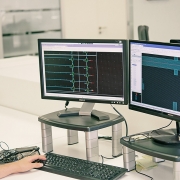Carlos Pardo speaks about IC shortage with Portal Movilidad
The forecasts for next year are better but will not be able to overcome the demand from the automotive industry and the other industries that need these components. Francisco Quatrin from Portal Movilidad has spoken with KDPOF CEO Carlos Pardo.
The semiconductor industry will not recover until 2024: What will happen to electric vehicles?
The microchip crisis that began in 2020 still seems to have no end. The industry predicted its end within the next few months, but the sector warns that it will have to wait at least two years for the situation to normalize. 2024 is the year that resonates among microchip and semiconductor industry specialists. “It took us almost a year to manufacture something that should be ready in four months,” says Carlos Pardo.
The shortage crisis was caused by three factors that converged at the beginning of the pandemic.
Firstly, it was caused by the fact that half of the world’s production means slowed down their production due to the health crisis. But on the other hand, demand for electronic devices soared. “Everyone had to connect from home, so the demand for tablets, computers and phones grew exponentially,” says Pardo.
A second factor was the automotive industry, which, when the quarantines began, its production was greatly reduced and so was demand. People stopped buying cars. There was a mismatch in global supply there because the demand for microchips was going into the production of other items and not the automobile. “When the automotive sector woke up, it started to want to produce and there was no capacity to support that demand, which was outstripped by supply,” explains KDPOF’s CEO. A conventional car needs up to 10 different types of microchips ranging from 65 nanometers to 85 nanometers, in the conventional. In other cases, there may be 180 and 190 or 16.
The third factor has to do with what happened last year when the supply was non-existent and the vehicle or electronics manufacturing companies started to stock up abruptly. Because of this, the stock of microchips was almost finished by the end of 2021 and made 2022 start with long delays in production. “All the companies are looking at growing and re-stocking, so supply is still below demand,” says Pardo.
What will happen in the future?
The forecast for next year is that the semiconductor industry will start to be able to cope with more demand but will remain below what is expected. Therefore there will be a lack of supply in 2023. “Part of the industry says it will improve because there will already be stock, but there are others who argue that it won’t and the need will still exist,” the CEO argues. Many of the large microchip factories, such as TSMC, have been investing in the last three years in new factories to meet this demand. With these new factories up and running, it is likely that manufacturing capacity will double and there will be more supply. But, Pardo warns: “What the sector is warning is that prices will not go down, because they will still have to amortize the costs of these factories”.
The Position of the Automakers
Toyota, the world’s largest automaker, is caught in the crisis situation of the lack of supply of microchips. The Japanese brand, as well as other manufacturers (such as Tesla) had better forecasts around the semiconductor crisis What is happening to them? Toyota is having serious problems in the supply of microchips. But the forecasts were relatively good and now, as August approaches, the Japanese brand has decided to reduce its production target for next month.
So, not only are they going to reduce their production during August, but they are also going to stop several of their facilities in Japan. Initially, Toyota had planned a production of 850,000 vehicles during the coming month of August. However, they have just adjusted this forecast to 700,000 vehicles.
According to the company’s own indications, production will be reduced due to the shortage of semiconductors. A significant cut of 18% in its manufacturing which, for the time being, will not affect annual production.
The original Spanish feature from July 26, 2022 is available at portalmovilidad.com/










